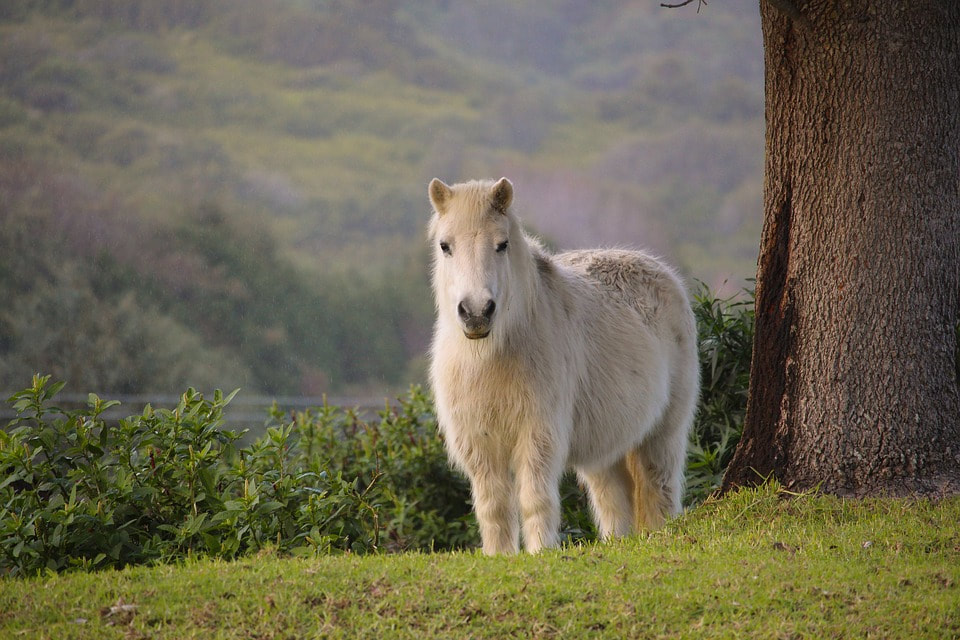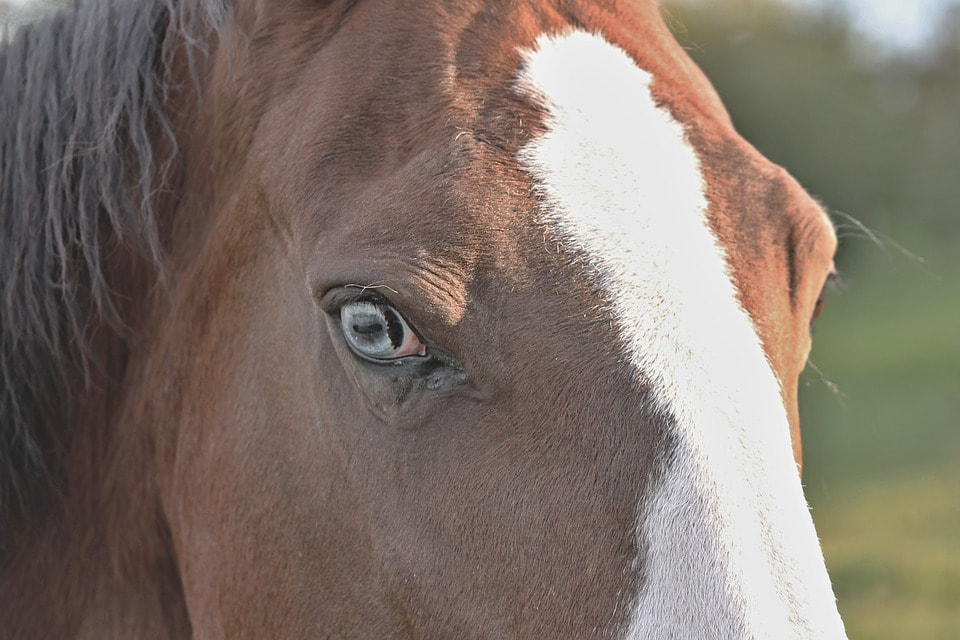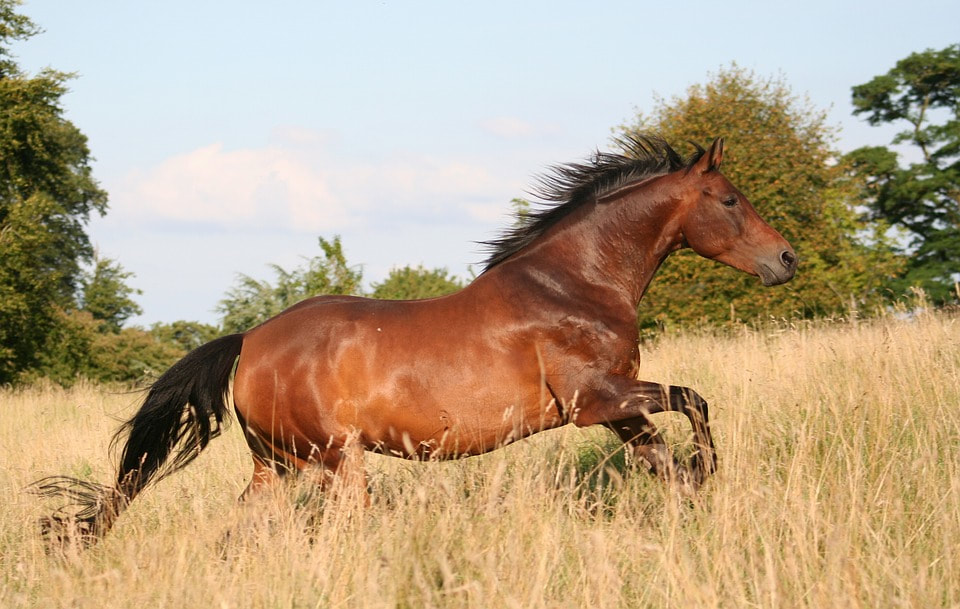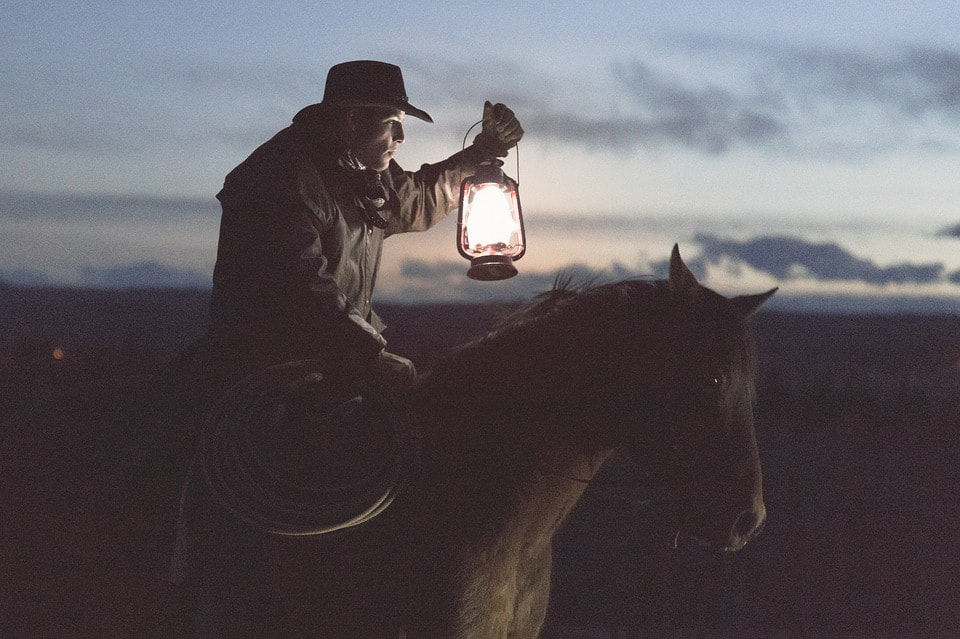50+ Interesting Fun Facts
About Horses
(And Lots of Awesome Horse Pictures)
Fun Fact # 1: Horses have nearly 360 degrees of vision.
Horses have eyes on the side of their head to enable them to spot predators quickly and easily. They only have a couple blind spots where they can't see you at all; directly in front of them and directly behind them. Always be careful and let the horse know when you're in one of their blind spots.
2. Horses can sleep standing up or lying down.
Due to a unique ability to lock their knees, horses can sleep lying down as well as standing up. This ability helps wild horses survive predators prowling around at night, as they can wake up and run immediately without needing to scramble to their feet first. Horses usually lie down only when they feel comfortable and secure enough to do so. When in a herd, it is rare for all horses to sleep lying down simultaneously, as one typically stands on guard to look out for predators.
3. Horses are measured in "hands."
A horse's height is measured at their withers (the highest point on the horse's back, between the neck and the back.)
Each "hand" equals 4 inches. A double h (hh) is a short form that refers to "hands high" and is typically used after the number of hands that a horse measures. For example, a horse that is 60 inches tall at the withers is 15hh. If a horse doesn't fall exactly on an even hand number, their number will look something like 15.2hh for example (which is equivalent to 62 inches high.) Since there are only 4 inches in a hand, 15.2 is also known as 15 and a half hands high. Every 4 inches, you start counting the next hand. So it would look something like this:
15hh = 60 inches tall at the withers
15.1hh = 61 inches tall
15.2 = 62 inches tall
15.3 = 63 inches tall
16hh = 64 inches tall
16.1hh = 65 inches tall, etc.
Each "hand" equals 4 inches. A double h (hh) is a short form that refers to "hands high" and is typically used after the number of hands that a horse measures. For example, a horse that is 60 inches tall at the withers is 15hh. If a horse doesn't fall exactly on an even hand number, their number will look something like 15.2hh for example (which is equivalent to 62 inches high.) Since there are only 4 inches in a hand, 15.2 is also known as 15 and a half hands high. Every 4 inches, you start counting the next hand. So it would look something like this:
15hh = 60 inches tall at the withers
15.1hh = 61 inches tall
15.2 = 62 inches tall
15.3 = 63 inches tall
16hh = 64 inches tall
16.1hh = 65 inches tall, etc.
4. Horses are strict plant eaters.
A horse's diet consists of 100% plant based foods. Hay and grass makes up the majority of a horse's forage, and they also sometimes eat grain, fruits, and veggies (such as apples and carrots.) Horses should never eat processed people food, meat, or dairy.
5. Horses have been kept alongside people for over 5000 years.
Over the years, horses have evolved alongside people, and have been a part of countless human activities throughout the times; from the days they participated in wars and were used as everyday transportation, to being involved in the entertainment industries and companionship/pleasure riding equines of today.
6. Horses are categorized by gender, age, and more.
Stallions are known as mature male horses, whereas mares are mature females. A foal is a baby horse, categorized more specifically as a colt (baby male horse) or a filly (baby female horse.) Additionally, weanlings are known as young horses that have recently been weaned from their mom, and yearlings are horses that are around a year old. A gelding is a mature male horse that has been gelded (unable to breed.) Geldings tend to be much easier to handle and ride than stallions. Ponies are classified as a small horse under 14.2hh.
7. Horses have 4 primary gaits.
Horses typically have 4 gaits (speeds) at which they move: walk, trot, canter, and gallop. However, some horses referred to as "gaited" horses have an additional pace, which is very smooth to ride. Certain breeds, like the Tennessee Walking horse, Paso Fino, Icelandic, Rocky Mountain horse, and several more breeds are more likely to be naturally gaited and very smooth to ride under saddle.
8. Horses run at an average of 27 mph.
Horses can generally gallop at around 27 miles per hour (44 kilometers per hour) However, the fastest sprint recorded by a horse was an incredible 55 mph (88 kph).
9. Ponies are smaller in size, but big in personality.
Ponies are small sized horses, measuring 14.2hh or smaller. Ponies are very strong and hardy for their size, and typically have a sturdier build than bigger horses. If the size difference between horses and ponies were eliminated, ponies would exceed most horses in strength and power. They are also extremely easy keepers and would require only half as much food as a horse would if they were the same size.
Ponies also have a unique (and sometimes mischievous) personality often dubbed as "ponytude." Some ponies can be stubborn, or try to outsmart their little riders and see what they can get away with. They are curious and friendly little equines, but they also aren't afraid to stand up to a much bigger horse.
Ponies have thicker manes and tails than horses and also grow an extra thick, fluffy coat in the cold weather to help protect them from the elements and enable them to live outside more comfortably in all types of weather. They also have shorter legs, thicker necks, and shorter heads when compared to horses. In addition, ponies are generally healthy and long lived, often outliving many taller horse breeds.
Ponies also have a unique (and sometimes mischievous) personality often dubbed as "ponytude." Some ponies can be stubborn, or try to outsmart their little riders and see what they can get away with. They are curious and friendly little equines, but they also aren't afraid to stand up to a much bigger horse.
Ponies have thicker manes and tails than horses and also grow an extra thick, fluffy coat in the cold weather to help protect them from the elements and enable them to live outside more comfortably in all types of weather. They also have shorter legs, thicker necks, and shorter heads when compared to horses. In addition, ponies are generally healthy and long lived, often outliving many taller horse breeds.
10. Horses can be crossbred with donkeys.
The most common mix between horses and donkeys consists of a male donkey and a female horse, resulting in offspring known as a mule. A cross between a male horse and a female donkey is called a hinny. These mixed equines tend to be strong for their size, yet stubborn (comes from their donkey side!) Their appearance looks like a donkey and horse thrown together into a blender; giant ears with kind of a donkey looking face, but still carrying many of the features from their horse half.
11. A "Flehmen" response is a way for horses to identify a new or strange smell.
While it may look like horses are laughing, a "Flehmen response" is a behavior that horses typically do in response to a strange smell. Stallions will often do this in response to a mare, or when sniffing manure or urine from other horses. However, horses of any age and gender can have the same response to a new smell or taste.
Some people put this behavior on cue by exposing their horse to a funny smell, or tickling their nose or gums to get the response, and giving a treat as soon as the horse does it. Once they are frequently curling their lip up to try to elicit a treat from you, add a cue such as "smile" and give a treat as soon as the horse offers the behavior again.
Some people put this behavior on cue by exposing their horse to a funny smell, or tickling their nose or gums to get the response, and giving a treat as soon as the horse does it. Once they are frequently curling their lip up to try to elicit a treat from you, add a cue such as "smile" and give a treat as soon as the horse offers the behavior again.
12. Male and female horses have different numbers of teeth.
Male horses typically have 40 teeth, whereas females only have 36. As long as the horse hasn't lost teeth, this is theoretically one way to tell a horse's gender (although, it's not the simplest method!)
13. The Przewalski's Wild Horse is the last true wild horse species still roaming.
The Przewalski's Wild Horse is the only true wild horse still remaining in the wild. The remainder of the Przewalski's horses currently roam free in Mongolia. While they are the only true wild horse species remaining, there are still many feral herds of horses (such as mustangs) roaming in various places around the world.
14. An adult horse's brain weighs 22 oz.
A full grown horse's brain weighs approximately 22 ounces, which is about half the weight of a person. Their teeth actually take up more space in their head than their brain.
15. A horse's heart can weigh 10 pounds.
In comparison to the brain, their heart is much bigger, weighing about 9-10 pounds. On average, a human's heart only weighs around 11 ounces.
16. Horse hooves consist of the same protein as human hair and fingernails.
Horse hooves are also continuously growing, just like our hair and nails. Trimming a horse's hooves is painless, just like when we get a haircut or trim our fingernails when they grow too long.
17. Foals can run shortly after birth.
While they start out quite wobbly and awkward on their long legs, foals learn to stand and nurse almost immediately, and some are able to run within hours of being born.
18. Miniature horses are even smaller than ponies.
While miniature horses are much smaller than the designated horse size (14.3 hands high) they are still referred to as "horses." Despite being smaller than ponies, minis have the appearance and features of a full sized horse rather than the stocky build of a pony. Miniature horses are often under 34-38 inches tall (8.2 - 9.2hh), and most are too small to be ridden even by children.
19. Horses have bigger eyes than any other mammal that lives on land.
20. The oldest horse is said to have lived to be 62 years old.
A horse named "Old Billy" apparently lived to the ripe old age of 62. In comparison, most horses live to an average age of 25. Ponies often go longer, sometimes remaining healthy into their thirties or later.
21. Horses have around 205 bones in their skeleton.
22. At one time, people thought horses were colorblind.
They're not colorblind, but they can only see two out of three visible wavelengths in the light spectrum. This means they see certain colors but not all. Blues and greens are visible to them, but bright colors of red or orange may look brown or green in a horse's eyes.
Although they can't see all the same colors, a horse has much better night vision than humans. Horses have a membrane at the back of the eye called the tapetum lucidum, which reflects light. It takes a horse's eyes longer to adjust from light to dark, which is why horses often blink a lot when the barn lights are turned on suddenly, or why they may not want to walk into a dark horse trailer.
Although they can't see all the same colors, a horse has much better night vision than humans. Horses have a membrane at the back of the eye called the tapetum lucidum, which reflects light. It takes a horse's eyes longer to adjust from light to dark, which is why horses often blink a lot when the barn lights are turned on suddenly, or why they may not want to walk into a dark horse trailer.
23. The horse trailer was invented by Lord George Bentinck.
The horse trailer (originally known as a horse box) was invented by a UK man named Lord George Bentinck. Boats and trains were the earliest methods of transport, but Bentinck needed a more effective method to transport his six racehorses from one racetrack to another.
24. Horses use their eyes, ears, and nostrils to show their emotions.
Horses use lots of different signs and a combination of signals from their eyes, ears, and nose to express their mood and feelings. They also use facial expressions. Horses can use more facial expressions to communicate their mood than dogs, although less than people.
25. In 1872, it was proven that horses have all 4 feet off the ground at one point while galloping.
In 1872, Leland Stanford made a bet that all four of a horse's feet come off the ground at one point while galloping. A man named Eadweard Muybridge proved him right by setting up a line of 24 cameras and photographing a racehorse named Sallie Gardner.
26. There are approximately 60 million horses in the world.
While it's hard to pinpoint an exact number, estimates suggest there are an incredible 60 million horses on the earth today. The vast majority of those 60 million are domesticated and cared for by humans.
27. Approximately 4.6 million Americans work in the horse industry.
Around 4.6 million Americans work in the horse industry, either directly or indirectly with horses. The horse industry in the USA brings in about $39 billion each year. In comparison, there are only about 9 million horses residing in America.
28. Horses use many different sounds to communicate with one another.
Horses use various types of vocalizations to communicate with other horses. Whinnying and neighing are typically used to greet one another or call out from a distance, whereas quieter snorts may be used as a signal to alert others to a potential danger. Squeals are often exchanged by horses meeting for the first time or working out their rank in the herd.
29. Horses can't throw up.
Horses are physically unable to vomit, due to a powerful muscle valve between their esophagus and stomach. This band of muscle works as a one way valve that allows food to come down, but not back up. Their inability to vomit makes some illnesses (such as colic) potentially fatal for them.
30. Horses can see better at night than humans.
However, it takes less time for a human's eyes to adjust from light to dark (and vice versa) than a horse.
31. From 1867 to 1920, the horse population jumped significantly.
During this time, the number of horses notably increased from 7.8 million up to 25 million. This jump was likely due to the rise of the automobile during that time.
32. There are around 400 horse breeds.
While there is only one species of domesticated horse, there are approximately 400 breeds within the species. These breeds range in size and build, and most specialize in different disciplines from racing, to ranching, to pulling carts.
33. Horses can produce up to 10 gallons of saliva a day.
Additionally, the average horse drinks about 5-10 gallons of fresh water each day.
34. Wherever the horse's ears are pointing is most often where they are looking.
Typically, the direction a horse's ear is pointing is indicative of where they are looking with the eye on the same side. If the ears are pointing in different directions, the horse is looking at two different things at the same time.
35. Wild horses typically live in groups of 3-20 horses.
These family groups usually consist of one stallion, several mares, and their offspring. Among the mares, one emerges as the lead mare and decides when the herd will graze, drink, and sleep, and where they will travel. The stallion is responsible for protecting the herd and defending his mares from other stallions. When colts (young males) in the herd hit maturity at around 2 years of age, the stallion will drive them away from the herd. These young stallions form their own bachelor herds until they are able to challenge other stallions and obtain their own herd.
36. Horses like sweet flavors.
Horses are typically less fond of sour or bitter tasting foods and more likely to turn them down than sweeter flavored treats.
37. The first cloned horse was a haflinger mare in Italy in 2003.
38. Part of the horse's hoof is called a "frog."
The center of a horse's hoof is called a "frog." The frog is a triangular shaped section in the middle of the hoof and the most sensitive part of the hoof. The frog acts as a shock absorber for the horse's leg, and helps to pump blood back up the leg.
39. The longest jump by a horse over water was more than 27 feet!
A horse named "Something" and his rider Andre Ferreira hold the record for the longest jump over water. Something cleared an impressive jump of 27 feet, 6 and 3/4 inches on April 25, 1975 in Johannesburg, South Africa.
40. The record for the highest jump by a horse is over 8 feet.
Additionally, the record set for the highest jump by a horse was 8 feet, 1 and 1/4 inches. This record is held by a horse named Huaso, and was set on February 5th, 1949 in Vina del Mar, Chile. He was ridden by Captain Alberto Larraguibel.
41. Mounting horses from the left side started during war times.
During war days, soldiers would always get on and off their horses on the left so the horses wouldn't be hit with their swords. Riders continued that tradition after the war, all the way into the current day.
42. Horses are honored in many cultures.
Many cultures (such as China) consider horses a very honorable animal, largely due to their involvement in heroic exploits in war.
43. You can tell if a horse is cold by feeling behind their ears.
If the area directly behind their ears is cold, it typically indicates that the rest of the horse is cold as well.
44. Horses have 16 muscles in each ear.
These muscles allow them to rotate their ears up to 180 degrees.
45. A horse's eyes are the same size at birth as they are fully grown.
46. Horses can move their skin independently.
Horses can move their skin independent of the major muscles beneath it. You can see this mostly in the summer when horses twitch their skin to get flies off their body. This is particularly helpful to keep flies away from the areas they can't reach very easily.
47. Horses are highly social animals.
Horses love being around others of their own kind. They will get lonely if kept alone and also mourn the passing of a companion.
48. A "Zebroid" is a cross between a zebra and an equine.
A "zebroid" is known as a cross of a zebra and any other member of the equine family (ie. horses, ponies, or donkeys.) More specifically, a cross of a zebra and horse is called a "zorse," a zebra and pony is called a "zony," and the mix of a zebra with a donkey is considered a "zonkey."
49. Horses with pink skin can get a sunburn.
Some lighter colored horses are most susceptible to this. On these horses, the muzzle is often particularly sensitive to the sun as they have less hair than the rest of the body.
50. The Morgan horse is the only breed to be named after an individual.
The Morgan horse breed was named after Justin Morgan, who was a Vermont school teacher. A horse named Figure was often referred to as "Morgan's horse," which was how the breed originally got its name.
51. The tallest horse ever on record was over 21 hands high!
The tallest horse ever on record is a Shire horse named Sampson. He was an incredible 21.2 hands (7 feet, 2 inches) tall at the withers. He was born in 1846 in Toddington Mills, England.
The oldest living horse currently is Big Jake (pictured above) a Belgian gelding standing 20 hands and 2.75 inches (82.75 inches) tall at the withers. He set the record at Smokey Hollow Farms in Poynette, Wisconsin, USA on January 19, 2010.
The oldest living horse currently is Big Jake (pictured above) a Belgian gelding standing 20 hands and 2.75 inches (82.75 inches) tall at the withers. He set the record at Smokey Hollow Farms in Poynette, Wisconsin, USA on January 19, 2010.
52. Horses have evolved over the last 50 million years from much smaller creatures.
Scientists believe that the horses we know today evolved from much smaller creatures that roamed the earth about 50 million years ago. These "prehistoric horses" are called Eohippus. They had four padded toes on their front feet and three padded toes on their back feet.
53. Horses can't breathe through their mouth.
Horses are typically born as "obligate nasal breathers" meaning they can only breathe through their nostrils and not their mouths. This helps prevent horses from inhaling food.
54. One leg/side of the horse is shorter than the other.
Horses usually are slightly shorter on one side than the other (kind of like how people may have one foot a slightly different size than the other.) You can tell which side is shorter by which side that the horse's mane lies on naturally.
55. Thoroughbred horses all share a birthday of January 1st.
Regardless of when the horse was actually born, all Thoroughbreds are given an official birthday of January 1st. This means a Thoroughbred born on December 31st will technically turn 1 year old the next day. Breeders raising Thoroughbreds for racing will do everything they can to make sure their foals are born in the first half of the year, as close to January as possible. The shared birth date for Thoroughbreds is done to standardize the racing industry and make it simpler to put horses into the correct age grades for races.
Sources & More Info
ScienceKids.co.nz -> Fun Horse Facts for Kids
DoubleDTrailers.com -> 45 Most Random, Amazing and Bizarre Facts About Horses
DoubleDTrailers.com -> 45 Most Random, Amazing and Bizarre Facts About Horses

























































